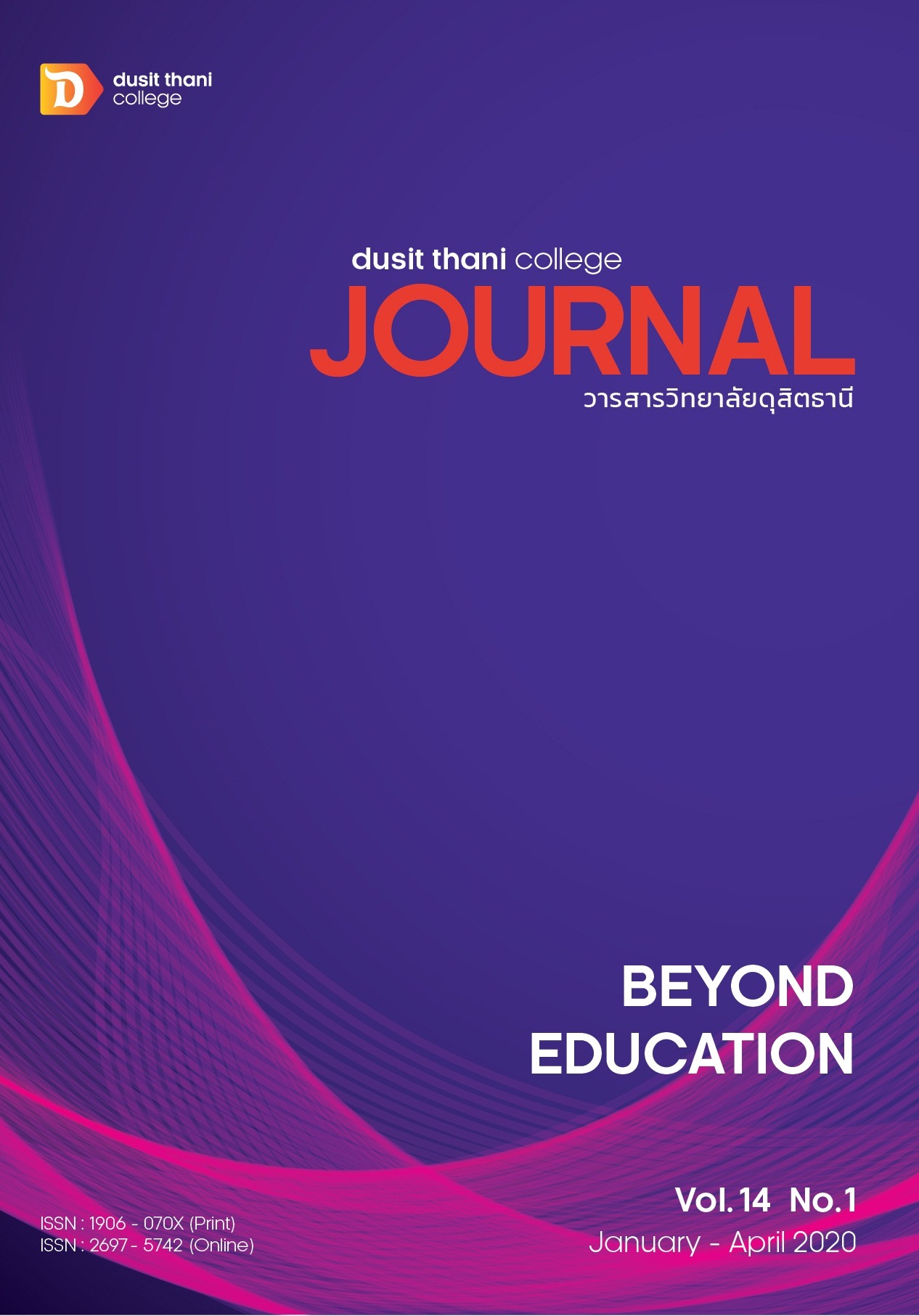การสร้างแบบวัดความวิตกกังวลในการเรียนภาษาอังกฤษของนักศึกษา วิทยาลัยดุสิตธานี พัทยา
Main Article Content
บทคัดย่อ
การวิจัยนี้มีวัตถุประสงค์เพื่อสร้างแบบวัดความวิตกกังวลในการเรียนภาษาอังกฤษให้เหมาะสมกับนักศึกษาวิทยาลัยดุสิตธานี พัทยา และตรวจสอบคุณสมบัติของแบบวัด การพัฒนาแบบวัดนี้ใช้หลักการแปลไปและแปลกลับจากแบบวัดต้นแบบ จากนั้นตรวจสอบความตรง ความเที่ยง และอำนาจจำแนกของแบบวัดโดยการตรวจสอบความตรง มีการตรวจสอบความตรงเชิงเนื้อหาและความตรงเชิงโครงสร้าง โดยใช้การวิเคราะห์องค์ประกอบเชิงยืนยันอันดับสอง จากตัวอย่างทั้งหมด 240 ตัวอย่าง ที่ได้จากการสุ่มแบบหลายขั้นตอน
ผลการวิจัยแสดงให้เห็นว่า แบบวัดความวิตกกังวลในการเรียนภาษาอังกฤษสำหรับนักศึกษาวิทยาลัยดุสิตธานี พัทยา ประกอบด้วยความวิตกกังวลในทักษะ การฟัง การพูด การอ่านและการเขียน โดยในแต่ละทักษะวัดความวิตกกังวลจาก ความวิตกกังวลที่แสดงออกมาอย่างชัดเจน (Cognitive) ความวิตกกังวลที่ร่างกายแสดงออกมา (Somatic) และพฤติกรรมการหลีกเลี่ยงการเรียนภาษาอังกฤษ (Behavioral) แบบวัดนี้มีความเที่ยง ความตรงเชิงเนื้อหา และความตรงเชิงโครงสร้างที่ดี รวมทั้งแบบวัดนี้มีความเที่ยงและอำนาจจำแนกที่ดี โดยมีค่าสัมประสิทธิ์แอลฟ่า .97 และค่าอำนาจจำแนก .31-.79 ในการประเมินความวิตกกังวลควรให้ความสำคัญกับทักษะการพูดและทักษะการอ่าน เป็นอันดับแรก รองลงมาคือ ทักษะการฟังและการเขียน ตามลำดับและในแต่ละทักษะควรให้ความสำคัญกับ Somatic เป็นอันดับแรกรองลงมาคือ Behavioral และ Cognitive ตามลำดับ
Article Details
นโยบายการพิจารณากลั่นกรองบทความ
- บทความวิจัยและบทความวิชาการทุกเรื่องที่จะได้รับการตีพิมพ์ต้องผ่านการพิจารณากลั่นกรองโดยผู้ทรงคุณวุฒิ (Peer Review) ในสาขาที่เกี่ยวข้อง จำนวน 3 ท่าน/บทความ
- บทความ ข้อความ ภาพประกอบและตารางประกอบที่ลงตีพิมพ์ในวารสารเป็นความคิดเห็นส่วนตัวของผู้เขียน กองบรรณาธิการไม่จำเป็นต้องเห็นด้วยเสมอไป และไม่มีส่วนรับผิดชอบใด ๆ ถือเป็นความรับผิดชอบของผู้เขียนแต่เพียงผู้เดียว
- บทความที่จะได้รับการตีพิมพ์จะต้องไม่เคยตีพิมพ์ เผยแพร่ที่ใดมาก่อน และไม่อยู่ระหว่างการพิจารณาของวารสารฉบับอื่น หากตรวจสอบพบว่ามีการตีพิมพ์ซ้ำซ้อน ถือเป็นความรับผิดชอบของผู้เขียนแต่เพียงผู้เดียว
- บทความใดที่ผู้อ่านเห็นว่าได้มีการลอกเลียนหรือแอบอ้างโดยปราศจากการอ้างอิง หรือทำให้เข้าใจผิดว่าเป็นผลงานของผู้เขียน กรุณาแจ้งให้กองบรรณาธิการวารสารทราบจะเป็นพระคุณยิ่ง
เอกสารอ้างอิง
intervention in extensive listening compared with standard foreign language instruction. Perceptual and motor skills, 110(2), 355 - 365.
2. Chang, H. C., Fang, W. C., Yang, B. H., Luo, B. R., Chew, S. W., & Chen, N. S. (2017).
Examining the relationships between foreign language anxiety and attention during conversation tasks. In Innovations in Smart Learning (pp. 1 - 11). Springer, Singapore.
3. Cheng, Y. S., Horwitz, E. K., & Schallert, D. L. (1999). Language anxiety: Differentiating
writing and speaking components. Language Learning, 49, 417 - 446.
4. Cheng, Y. S. (2004). A measure of second language writing anxiety: Scale development
and preliminary validation. Journal of second language writing, 13(4), 313 - 335.
5. Cheng, Y. S. (2017). Development and preliminary validation of four brief measures of L2 language-skill-specific anxiety. System, 68, 15 - 25.
6. Choi, Y. (2013). Teaching social studies for newcomer English language learners: Toward culturally relevant pedagogy. Multicultural Perspectives, 15(1), 12 - 18.
7. Elkhafaifi, H. (2005). Listening comprehension and anxiety in the Arabic language
classroom. The Modern Language Journal, 89, 206 - 220.
8. Horwitz, E. K. (2001). Language anxiety and achievement. Annual Review of Applied
Linguistics, 21, 112 - 126.
9. Kubzansky, L. D., Kawachi, I., Weiss, S. T., & Sparrow, D. (1998). Anxiety and coronary heart disease: a synthesis of epidemiological, psychological, and experimental evidence. Annals of Behavioral Medicine, 20(2), 47 - 58.
10. MacIntyre, P. D. (1999). Language anxiety: A review of the research for language teachers. In D. J. Young (Ed.), Affect in foreign language and second language learning:
A practical guide to creating a low-anxiety classroom atmosphere (pp. 24 - 45). Boston: McGraw-Hill College.
11. Lang, P. J. (1971). The application of psychophysiological methods to the study of psychotherapy and behavior modification. Handbook of psychotherapy and behavior change, 75 - 125.
12. Polit, D. F., & Beck, C. T. (2009). Essentials of nursing research: Appraising evidence for
nursing practice. Lippincott Williams & Wilkins.
13. Suksawang, P. (2014). The basics of structural equation modeling. Pricesss of Naradhiwas University Journal, 6(2), 136 - 145. (in thai).
14. Schumacker, R. E., & Lomax, R. G. (2016). A beginners guide to structural equation
modeling. New York: Routledge.
15. Yamashita, J. (2013). Effects of extensive reading on reading attitudes in a foreign
language. Reading in a Foreign Language, 25(2), 248 - 263.


